1. Meaning of Gudipadwa
The Gudi with an auspicious sankalpa is hoisted on the pratipada (first day) of the bright fortnight of the Hindu lunar month of Chaitra in the Vasant rutu of Uttarayan (Six-month period between Makar Sankranti (January 14) and Karka Sankranti (around July 14), when the sun travels towards the north on the celestial sphere). It demonstrates the power of sankalp-shakti (Energy of resolve). Pratipada signifies that, ‘Henceforth every step we take will be a step ahead for our prosperity’; hence, any benevolent sankalpa made on this day will be fruitful. Hence, on this day we must hoist a Gudi symbolising a sankalp unto the Absolute Truth and thereby make an auspicious beginning. – H.H. Parashram Madhav Pande Maharaj, Sanatan Ashram, Devad, Panvel.
2. Sabhyang snan (Auspicious bath)
On Gudipadwa, one should wake up early in the morning and take a bath, that is a sabhyang snan (Manglik snan)
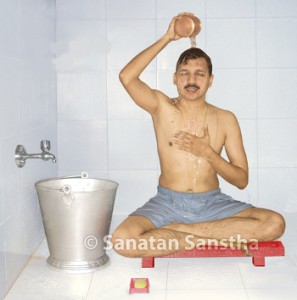
A. Definition
Sabhyang snan consists of an oil massage until oil is absorbed by the skin, followed by a warm water bath.
B. Days in the year for taking a sabhyang snan
1. First day of the year.
2. First day of the festival of Vasantotsav, meaning the Shukla paksha Pratipada (first day in the bright fortnight) of the Hindu lunar month of Phalgun.
3. The three days of Diwali, that is the Chaturdashi (fourteenth), the Amavasya (new moon day) of Ashvin and the Pratipada of lunar month of Kartik.
C. Benefits
1. After a bath, the Raja and Tama components decrease by 1/1,00,000 % and
Sattva component increases by the same amount; and their effect lasts for a duration of three hours. However, after a sabhyang snan the effect lasts for four to five hours.
2. Oil should be applied to retain the elasticity of the skin.
3. Warm water is auspicious and pleasing to the body. Bathing after an oil massage retains only requisite amount of oiliness in the skin and hair. Hence, an oil massage is necessary before a bath. Application of oil after a bath is inappropriate.
D. Utterance of the ‘desh-kal’ (time and place)
The deshkal is required to be uttered during a sabhyang snan.
Importance
The utterance of desh-kal encompasses everything – the number of years from the birth of Deity Brahma to date, the current manvantar (a period of 31,104,000 years started by Manu), the mahayug (great era) in that manvantar and the upayug (sub era) in that mahayug. It gives an idea of the vast time that has elapsed and that which is yet to come. We may think that we are someone great; however, from the vastness of the time of the Universe we can gauge how insignificant and small we are. Utterance of the desh-kal helps reduce the ego in us.
3. Decoration with toran (a bunting of mango leaves and red flowers)
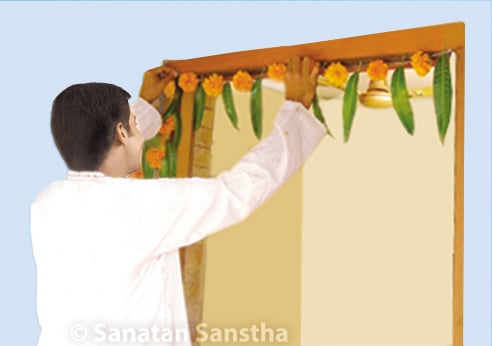
After a bath we should decorate the lintel of every door with a toran. Red flowers are used because red colour symbolizes auspiciousness.
4. Samvatsar-puja (Ritualistic worship)
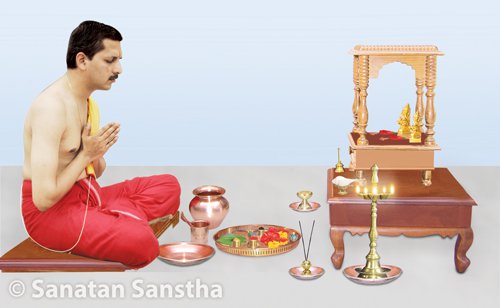
First puja is performed as a routine ritual. A Mahashanti is performed. The Mahashanti begins with the worship of Deity Brahma as He created the Universe on this day. He is offered davna during the worship. Later, hom (Fire-sacrifice performed to appease Deities) and havan (Offering of oblations in the fire) are performed along with offerings to Brahmans (One who belongs to the first of the four varnas (Classes), studies scriptures and imparts knowledge to the society). Then Shrivishnu, who manifests Himself in countless forms is worshipped. Obeisance is paid to Him by reciting the mantra – ‘नमस्ते बहुह्वपाय विष्णवे नमः ।’, meaning, ‘I bow to You O Shrivishnu, You who manifest in innumerable forms.’ Then the Brahmans are offered dakshina (Offering in cash or kind, especially one given to a Brahman after a ritual) and if possible historical and mythological texts are presented to them. It is said, that by performing this Mahashanti one is cleansed of all sins, no new sins are generated, the lifespan is increased and one becomes wealthy.
On this day the Deity of that day of the week is also worshipped. The following table gives the days of the week and the presiding Deity of that day.
| 1. Monday (Somvar) | Deity Shiva (Som means the moon and Var means the day) | 2. Tuesday | Devi Parvati / Devi Lakshmi / Shri Ganapati / Deity Hanuman |
| 3. Wednesday | Pandurang | 4. Thursday | Deity Datta |
| 5. Friday | Devi Parvati / Devi Lakshmi | 6. Saturday | Deity Hanuman |
| 7. Sunday (Ravivar) | Ravi means Sun |
A. Reason for offering davna in daily puja in the month of Chaitra
The table ahead compares the soothing effect of some substances. That will clarify why in the month of Chaitra when the weather changes and summer heat begins to be felt, davna is offered in the puja. Though sandalwood and davna have the same ability to impart a soothing effect, sandalwood can do so only when it is wet unlike davna which is effective throughout the day.
|
Substance |
Ability to bestow a soothing effect |
|
100 |
|
1 / 1 lakh |
|
1 / 10 lakh |
|
1 / 1 crore |
|
1 / 10 crore or even less |
– Divine knowledge obtained by H.H. Dr. Jayant Athavale in meditation.
B. Benefits of Samvatsar-puja
By performing a Samvatsar-puja, we get cleansed of our sins, our lifespan is prolonged, a woman’s married life is prolonged and we acquire peace.
5. Hoisting of Gudi
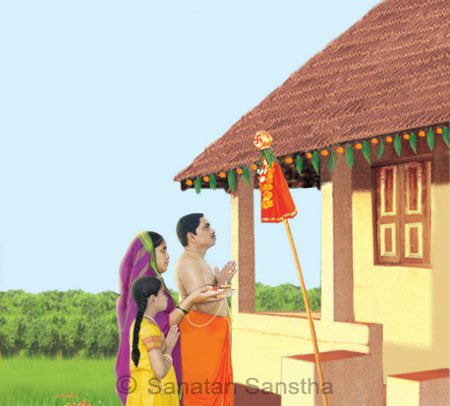
A. The Gudi (or the Brahma-dhwaj) is hoisted in every house as a symbol of victory and happiness. Since a symbol of victory is always held high, so is the Gudi.
B. Method of hoisting (Gudipadwa Videos – 8)
B1. After seeing the appropriate timing of the tithi (Lunar day) and the panchang , the Gudi should be hoisted immediately after sunrise.
B2. A bright green or yellow cloth adorned with zari (brocade) is tied to the tip of a long bamboo shoot, over which sugar candies, neem leaves, a twig of mango leaves and a garland of red flowers are tied.
This is then hoisted after placing a silver or copper kalash (pot) in an inverted position over it. The Gudi should be erected outside the main entrance on the ground, adjacent to the threshold, on the right hand side (when seen from the house). While erecting it, the Holy symbol of swastik should be drawn with a rangoli and the bamboo of the Gudi placed on the swastik. The Gudi should be slightly inclined towards the front, and not erect. Beautiful designs with rangoli should be drawn on the floor in front of it.
B3. Then uttering ब्रह्मध्वजाय नमः ।’, meaning, ‘I offer obeisance to the flag of Deity Brahma’ and accompanied by a sankalpa (Resolve), puja (Ritualistic worship) of the Gudi is performed.
B4. At the time of sunset the Gudi should be lowered after offering jaggery as Naivedya
C. Benefits
During Gudipadwa, the waves of the Prajapati Deity from the Universe descend onto the earth region in greater proportion. These Prajapati waves enter the house using the kalash as a medium. (This is akin to the antenna of a television set). The next day onwards, we should use the kalash for storing drinking water. A kalash charged with the Prajapati waves imparts them to the water stored in it. Thus, we benefit from the Prajapati waves throughout the year.
6. Donation
The needy should be given different kinds of offerings. For example offering free drinking water by setting up a stall. This appeases the ancestors.
7. Panchangshravan (Listening)
Perform puja and listen to the narration of the panchang from the astrologer or priest, meaning, benefits of the coming year.
Benefits –
तिथेश्च श्रीकरं प्रोक्तं वारादायुष्यवर्धनम् ।
नक्षत्राद्धरते पापं योगाद्रोगनिवारणम् ।।
करणाच्चिन्तितं कार्यं पञ्चाङ्गफलमुत्तमम् ।
एतेषां श्रवणान्नित्यं गङ्गास्नानफलं लभेत् ।।
Meaning : By listening to the discourse on tithis one acquires Lakshmi (wealth), that of the day of the week imparts longevity; that of lunar asterisms nullifies sins; listening to information on yog cures disease and achieves success in whatever one plans by listening to the entire narration. Listening to the panchang daily endows the merit equivalent to bathing in the Holy river Ganga.
8. Prasad of neem leaves
Importance
Since neem has the highest ability to absorb Prajapati frequencies as compared to any other substance, its leaves are partaken as prasad on this day. The table ahead gives the ability of certain substances to absorb these frequencies. From this we will learn why neem leaves are partaken on Gudipadwa day and milk, curd, ghee and sugar are avoided in the month of Chaitra.
Substance |
Ability to absorb waves % |
||
Prajapati |
Surya |
Yama |
|
| 1. Neem | 70 | 28 | 2 |
| 2. Rice, wheat, sorghum | 70 | 28 | 2 |
| 3. Coconut, mango, bananas | 60 | 38 | 2 |
| 4. Wild palm tree, coconut tree | 48 | 50 | 2 |
| 5. Milk, curd, clarified butter, sugar | 18 | 80 | 2 |
– Divine knowledge obtained by H.H. Dr. Jayant Athavale in meditation.
Method of preparing the special mixture of neem on Gudipadwa
Prepare this mixture by grinding neem leaves, neem flowers, pepper, asafoetida, salt, ajwain, sugar etc., mix it with tamarind and eat it.
The one who partakes the mixture is blessed with relief from diseases, destruction of disorders, happiness, knowledge, long life, wealth & prosperity.
(References and the method of making it are quoted in the Samvatsar Panchang of every year.)
9. Ploughing the soil
On this day fields should be ploughed. Ploughing churns the soil. The subtle soil particles get charged with the Prajapati waves and its ability to germinate seeds increases manifold. Akshata (unbroken rice grains, smeared with vermilion) should be sprinkled on the instruments used in farming and on the oxen amidst recitation of the mantra, which generates the Prajapati waves. Labourers working in the fields should be gifted with new clothes. The meal given to the labourers on this day should comprise of ripe pumpkin, lentil, rice, and a sweet prepared from gram lentil (cooked till soft and ground to a paste with jaggery) etc.
10. Performing activities, which bestow happiness
We should spend this day happily, listening to auspicious songs and stories of Holy men.
11. Spiritual Experience
Feeling the energy of Deity Hanuman after a prayer unto Him
and getting a vision of Hanuman when worshipping the Gudi
On 9th April 2005, the day of Gudipadwa I was assigned the seva of hoisting the Gudi in the Ashram. After a bath I reported early in the morning at the reception desk. At that time some seekers were unloading bags of wheat from a truck. I prayed to Deity Hanuman and began to assist them. Within fifteen minutes five seekers succeeded in unloading 82 bags of wheat. While doing so I felt the energy of Deity Hanuman infusing my body. In fact I had never before lifted such heavy bags. After this I could perform my seva of hoisting the Gudi and ritualistic worship in the planned time. I could perform the worship more confidently and with fewer mistakes. During the puja I was constantly getting a vision of Deity Hanuman and was experiencing chaitanya (Divine consciousness). – Mr. Nilesh Padhye

 From this Gudhi Padwa, resolve to establish Ramrajya in your personal and social life !
From this Gudhi Padwa, resolve to establish Ramrajya in your personal and social life !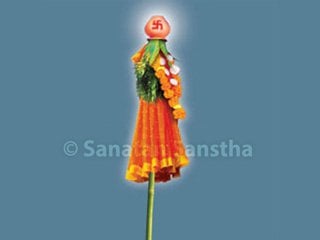 Gudhi : Importance and prayer to the Gudhi
Gudhi : Importance and prayer to the Gudhi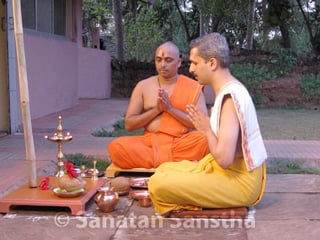 Ritualistic worship of the Brahmadhwaj (Gudi) on Gudipadwa
Ritualistic worship of the Brahmadhwaj (Gudi) on Gudipadwa
Nice post! I really liked your content on: Method of celebrating Gudi Padwa.
Keep writing such nice content.